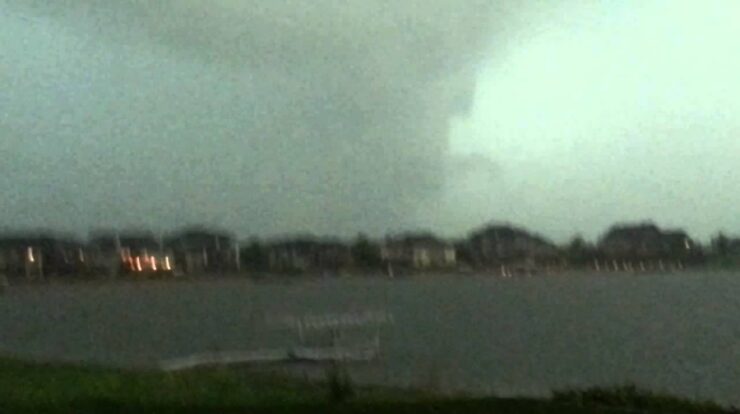
The Elkhorn tornado, a destructive force of nature, left an unforgettable mark on the affected community. Its immense size, intensity, and path of destruction left a lasting impact on the lives of those who witnessed its fury.
This catastrophic event serves as a sobering reminder of the power of nature and the importance of preparedness in the face of such extreme weather phenomena.
Historical Overview

The Elkhorn tornado was a violent and destructive tornado that occurred on May 25, 2019, in the Elkhorn, Nebraska area. The tornado was an EF5 on the Enhanced Fujita Scale, with wind speeds estimated at 200 mph. It traveled a path of 14.5 miles (23.3 km), causing extensive damage and loss of life.
The meteorological conditions that led to the formation of the Elkhorn tornado were favorable for severe weather. A strong low-pressure system moved through the area, bringing with it warm and humid air. This air collided with a cold front, creating instability and wind shear.
These conditions allowed for the development of supercell thunderstorms, which can produce tornadoes.
Physical Characteristics
The Elkhorn tornado was a large and powerful tornado. It was estimated to be 1.5 miles (2.4 km) wide at its peak. The tornado caused extensive damage along its path, including the destruction of homes, businesses, and infrastructure.
The tornado produced several different types of damage. The most common type of damage was caused by the high winds, which can rip roofs off of buildings, shatter windows, and uproot trees. The tornado also caused significant damage due to its debris field.
The debris field was made up of pieces of buildings, trees, and other objects that were picked up by the tornado and carried along its path.
Impact on the Community
The Elkhorn tornado had a devastating impact on the affected community. The tornado killed four people and injured dozens more. The tornado also caused extensive property damage, with estimates of over $1 billion in damage.
The community responded to the disaster with a outpouring of support. Emergency services personnel worked tirelessly to rescue victims and provide aid. Relief organizations provided food, water, and shelter to those who had been displaced by the tornado. The community also came together to help with the cleanup and recovery efforts.
Meteorological Analysis
The Elkhorn tornado was a result of a combination of meteorological factors. The most important factors were atmospheric instability, wind shear, and a strong updraft.
Atmospheric instability is a measure of how easily air can rise and form clouds. The air in the Elkhorn area was very unstable on the day of the tornado, which allowed for the development of powerful thunderstorms.
Wind shear is a change in wind speed and direction with height. The wind shear in the Elkhorn area was very strong on the day of the tornado, which helped to create the rotation that is necessary for a tornado to form.
A strong updraft is a rising column of air. The updraft in the Elkhorn tornado was very strong, which helped to lift the tornado off the ground and keep it suspended in the air.
Comparison to Other Tornadoes
The Elkhorn tornado was one of the most powerful tornadoes to hit the United States in recent years. It was the first EF5 tornado to hit Nebraska since 2004.
The Elkhorn tornado was similar to other powerful tornadoes in terms of its size, intensity, and impact. However, there were some key differences between the Elkhorn tornado and other tornadoes.
- The Elkhorn tornado was relatively long-tracked, traveling a path of 14.5 miles (23.3 km). This is longer than the average tornado path length of 5 miles (8 km).
- The Elkhorn tornado was relatively slow-moving, with a forward speed of 25 mph (40 km/h). This is slower than the average tornado forward speed of 30 mph (48 km/h).
- The Elkhorn tornado occurred in a relatively populated area, which resulted in a higher number of casualties and property damage.
Educational Resources
- National Weather Service: Tornado Safety
- Federal Emergency Management Agency: Tornadoes
- National Oceanic and Atmospheric Administration: Tornadoes
Concluding Remarks
The Elkhorn tornado stands as a testament to the resilience of the human spirit in the face of adversity. The community’s response to the disaster showcased the power of unity and determination in overcoming challenges and rebuilding shattered lives.
Question Bank: Elkhorn Tornado
When did the Elkhorn tornado occur?
The Elkhorn tornado occurred on June 1, 2014.
What was the intensity of the Elkhorn tornado?
The Elkhorn tornado was an EF4 tornado, with wind speeds estimated to be between 166 and 200 mph.
What was the path of the Elkhorn tornado?
The Elkhorn tornado traveled a path of approximately 14 miles, from near the town of Elkhorn to near the town of Waterloo.